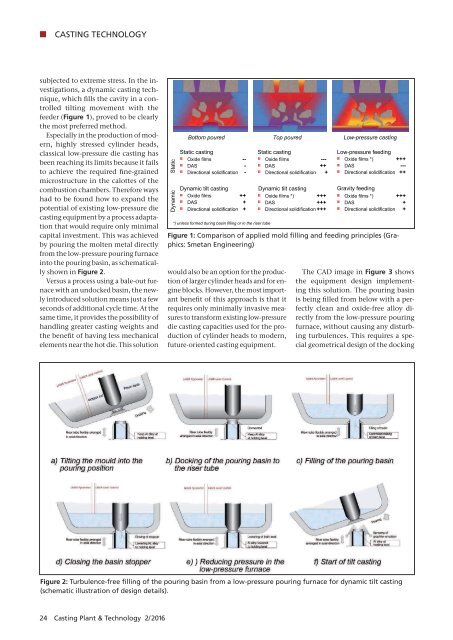CPT International 02/2016
The leading technical journal for the global foundry industry – Das führende Fachmagazin für die weltweite Gießerei-Industrie
The leading technical journal for the
global foundry industry – Das führende Fachmagazin für die
weltweite Gießerei-Industrie
Create successful ePaper yourself
Turn your PDF publications into a flip-book with our unique Google optimized e-Paper software.
K CASTING TECHNOLOGY<br />
subjected to extreme stress. In the investigations,<br />
a dynamic casting technique,<br />
which fills the cavity in a controlled<br />
tilting movement with the<br />
feeder (Figure 1), proved to be clearly<br />
the most preferred method.<br />
Especially in the production of modern,<br />
highly stressed cylinder heads,<br />
classical low-pressure die casting has<br />
been reaching its limits because it fails<br />
to achieve the required fine-grained<br />
microstructure in the calottes of the<br />
combustion chambers. Therefore ways<br />
had to be found how to expand the<br />
potential of existing low-pressure die<br />
casting equipment by a process adaptation<br />
that would require only minimal<br />
capital investment. This was achieved<br />
by pouring the molten metal directly<br />
from the low-pressure pouring furnace<br />
into the pouring basin, as schematically<br />
shown in Figure 2.<br />
Versus a process using a bale-out furnace<br />
with an undocked basin, the newly<br />
introduced solution means just a few<br />
seconds of additional cycle time. At the<br />
same time, it provides the possibility of<br />
handling greater casting weights and<br />
the benefit of having less mechanical<br />
elements near the hot die. This solution<br />
Dynamic Static<br />
Bottom poured Top poured Low-pressure casting<br />
Static casting<br />
Oxide films --<br />
DAS -<br />
Directional solidification -<br />
Dynamic tilt casting<br />
Oxide films ++<br />
DAS +<br />
Directional solidification +<br />
*) unless formed during basin filling or in the riser tube<br />
Static casting<br />
Oxide films ---<br />
DAS ++<br />
Directional solidification +<br />
Dynamic tilt casting<br />
Oxide films *) +++<br />
DAS +++<br />
Directional solidification +++<br />
Low-pressure feeding<br />
Oxide films *) +++<br />
DAS ---<br />
Directional solidification ++<br />
Gravity feeding<br />
Oxide films *) +++<br />
DAS +<br />
Directional solidification +<br />
Figure 1: Comparison of applied mold filling and feeding principles (Graphics:<br />
Smetan Engineering)<br />
would also be an option for the production<br />
of larger cylinder heads and for engine<br />
blocks. However, the most important<br />
benefit of this approach is that it<br />
requires only minimally invasive measures<br />
to transform existing low-pressure<br />
die casting capacities used for the production<br />
of cylinder heads to modern,<br />
future-oriented casting equipment.<br />
The CAD image in Figure 3 shows<br />
the equipment design implementing<br />
this solution. The pouring basin<br />
is being filled from below with a perfectly<br />
clean and oxide-free alloy directly<br />
from the low-pressure pouring<br />
furnace, without causing any disturbing<br />
turbulences. This requires a special<br />
geometrical design of the docking<br />
Figure 2: Turbulence-free filling of the pouring basin from a low-pressure pouring furnace for dynamic tilt casting<br />
(schematic illustration of design details).<br />
24 Casting Plant & Technology 2/<strong>2016</strong>


















